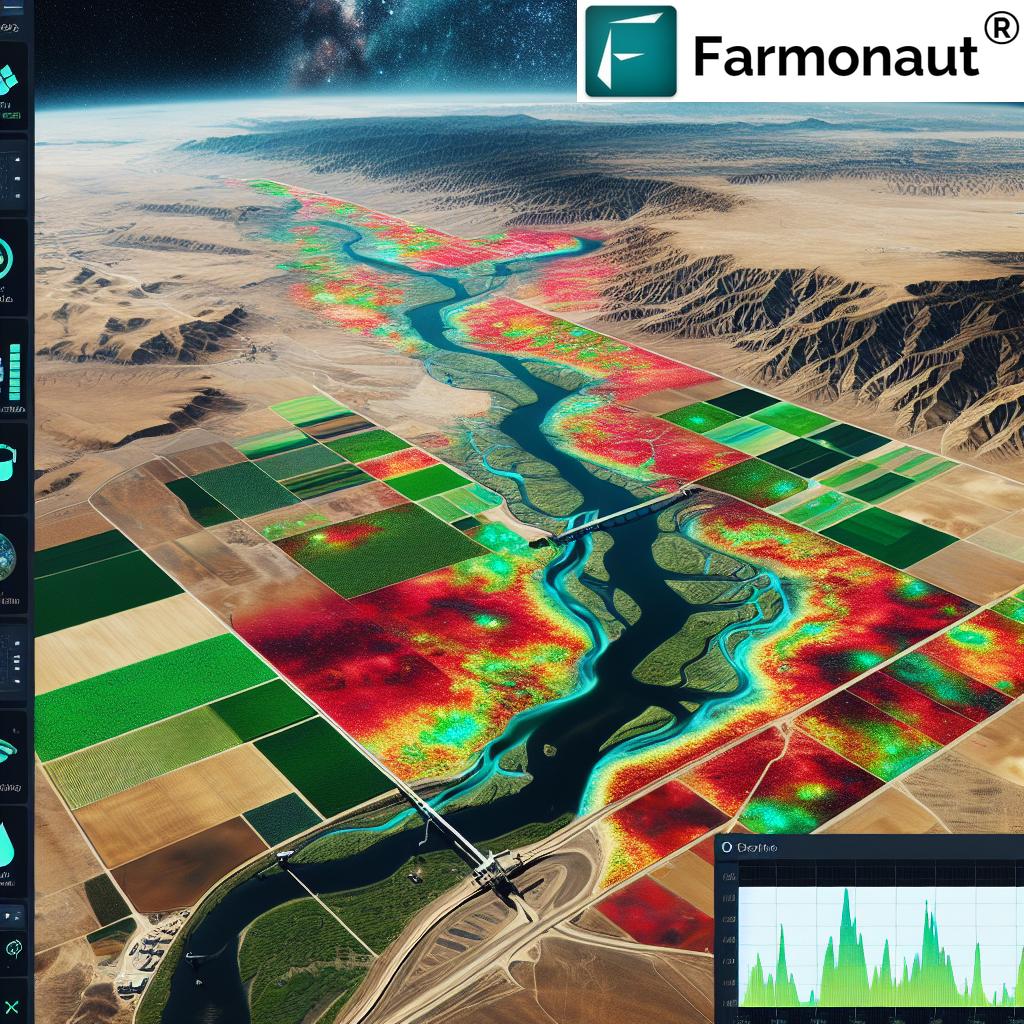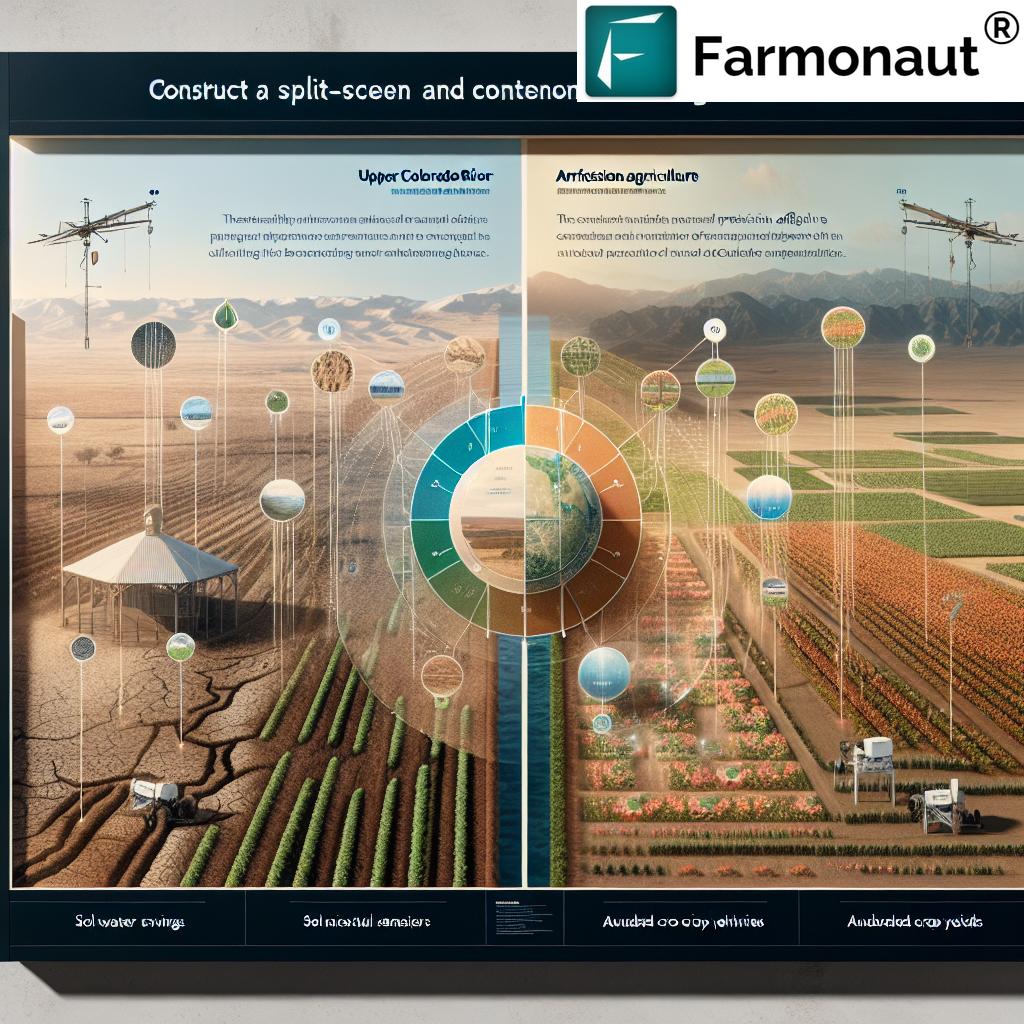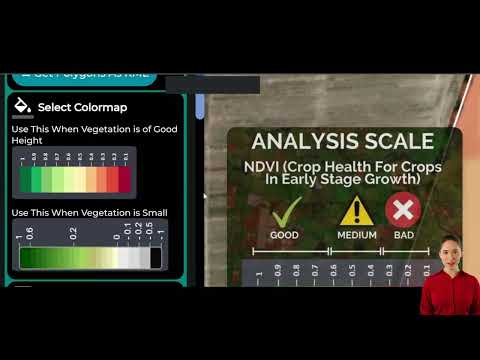Revolutionizing Colorado River Water Management: Satellite-Based Solutions for Sustainable Agriculture in the Face of Climate Change
“The Colorado River basin supplies water to seven western states, with current management guidelines set to expire in 2026.”
As we face the challenges of climate change and increasing water demands in the American West, the Colorado River basin stands at a critical juncture. With current water management guidelines set to expire in 2026, stakeholders across seven western states are grappling with the urgent need for innovative solutions to ensure sustainable water use, particularly in agriculture. In this comprehensive exploration, we’ll delve into the complexities of Colorado River water management and examine how satellite-based technologies are revolutionizing our approach to water conservation and sustainable farming practices.
The Colorado River Basin: A Vital Resource Under Pressure
The Colorado River is truly the lifeblood of the American West, sustaining over 40 million people across seven states and parts of Mexico. This crucial waterway not only supports agriculture and hydropower but also plays a vital role in maintaining delicate ecosystems. As we approach the expiration of current management guidelines, the stakes couldn’t be higher for the future of water use in the region.
- Upper Basin States: Colorado, New Mexico, Utah, and Wyoming
- Lower Basin States: Arizona, California, and Nevada
- Additional Beneficiaries: Two Mexican states and thirty Tribal Nations
It’s worth noting that 40% of Colorado’s water supply comes from this single river, underscoring its immense importance to the state’s agriculture and economy.
Proposed Management Alternatives: Navigating Uncertain Waters
Recently, the Bureau of Reclamation has put forward five management options aimed at restructuring future water management in the Colorado River basin. Three of these alternatives suggest “Basin-wide shared contributions,” which could potentially impose mandatory water cuts on Upper Basin states during dry years. This marks a significant shift, particularly for Colorado, and highlights the need for innovative approaches to water conservation and management.
Colorado River Commissioner Becky Mitchell has expressed support for the Upper Division States’ Alternative, which focuses on supply restoration at major reservoirs and aims to maintain water release capabilities crucial for meeting downstream obligations. This approach underscores the delicate balance between conservation efforts and fulfilling water rights commitments.

The Hardest Working River in America: Complex Negotiations Ahead
James Eklund, Mitchell’s predecessor, aptly described the Colorado River as “the hardest working river in America.” This characterization underscores the complex negotiations that lie ahead as basin states work to protect their interests while ensuring the long-term viability of this vital resource. The existing guidelines, established in 2007, are increasingly strained by the need for a new framework that can address the challenges posed by climate change and growing water demands.
Experts like Doug Kenney highlight the acute issues stemming from climate change, which has drastically reduced water availability and impacted reservoir levels. Rising temperatures lead to reduced stream flows and increased evaporation rates, further exacerbating the water supply challenges in the region.
Satellite-Based Solutions: A Game-Changer for Water Management
In the face of these challenges, satellite-based technologies are emerging as powerful tools for improving water management and agricultural practices in the Colorado River basin. These innovative solutions offer real-time insights into crop health, soil moisture levels, and water usage, enabling farmers and water managers to make more informed decisions.
At Farmonaut, we’re at the forefront of this technological revolution, offering advanced satellite-based farm management solutions that can play a crucial role in addressing the water challenges faced by the Colorado River basin.
Key Benefits of Satellite-Based Water Management:
- Precision Agriculture: Satellite imagery allows for precise monitoring of crop health and water needs, reducing water waste.
- Early Warning Systems: Real-time data helps identify potential drought conditions or water shortages before they become critical.
- Efficient Irrigation: Satellite-derived soil moisture data enables more efficient irrigation scheduling, conserving water resources.
- Crop Selection: Long-term climate data can inform decisions on which crops are most suitable for water-stressed regions.
Sustainable Agriculture in Water-Stressed Regions
As the Colorado River basin faces increasing water scarcity, the need for sustainable agricultural practices becomes paramount. Satellite-based technologies are playing a crucial role in helping farmers adapt to these challenging conditions:
- Drought-Resistant Crop Varieties: Satellite data can help identify areas suitable for drought-resistant crops, reducing overall water demand.
- Precision Irrigation: By providing detailed information on soil moisture and crop health, satellite monitoring enables farmers to apply water only where and when it’s needed most.
- Water Conservation Technologies: Satellite-derived insights can guide the implementation of water-saving technologies like drip irrigation and smart sprinkler systems.
Our Farmonaut platform integrates these advanced technologies to provide farmers with the tools they need to thrive in water-stressed environments. By leveraging satellite data and AI-driven insights, we’re helping to drive more sustainable agricultural practices across the Colorado River basin and beyond.
Climate Change Impacts on Water Resources
“Lake Powell, a major reservoir on the Colorado River, has reached historic low water levels due to climate change impacts.”
The effects of climate change on the Colorado River basin are becoming increasingly apparent, with significant implications for water management and agriculture:
- Reduced Snowpack: Warmer temperatures are leading to decreased snowpack in the Rocky Mountains, the primary source of water for the Colorado River.
- Earlier Spring Runoff: Snowmelt is occurring earlier in the year, affecting the timing of water availability for agriculture.
- Increased Evaporation: Higher temperatures are causing greater evaporation from reservoirs and irrigation systems, further straining water resources.
These climate-driven changes underscore the need for adaptive management strategies and innovative technologies to ensure sustainable water use in the face of uncertainty.

Efficient Irrigation Systems: A Key to Water Conservation
As water becomes increasingly scarce in the Colorado River basin, the adoption of efficient irrigation systems is crucial for sustainable agriculture. Satellite-based technologies are playing a pivotal role in optimizing these systems:
- Smart Sprinkler Systems: Satellite data on soil moisture and weather patterns can inform automated sprinkler systems, ensuring optimal water application.
- Drip Irrigation: Precise crop health monitoring enables targeted drip irrigation, reducing water waste and improving crop yields.
- Soil Moisture Sensors: Satellite-derived soil moisture maps can guide the placement and calibration of in-field sensors for more accurate irrigation scheduling.
At Farmonaut, we’re committed to providing farmers with the tools they need to implement these efficient irrigation systems effectively. Our satellite-based crop monitoring services offer real-time insights that can significantly improve water use efficiency in agriculture.
Water Rights and Agriculture: Navigating Complex Legal Frameworks
The management of water rights in the Colorado River basin is a complex and often contentious issue, particularly as it relates to agriculture. As we move towards new management guidelines, it’s crucial to understand the intricate legal frameworks that govern water allocation:
- Prior Appropriation Doctrine: This “first in time, first in right” principle governs water rights in many western states, including those in the Colorado River basin.
- Interstate Compacts: Agreements like the Colorado River Compact of 1922 dictate how water is shared between Upper and Lower Basin states.
- Tribal Water Rights: Many Native American tribes have significant water rights that must be considered in any management decisions.
Satellite-based technologies can play a crucial role in ensuring compliance with these complex water rights agreements. By providing accurate, real-time data on water usage and availability, these tools can help prevent disputes and ensure fair allocation of this precious resource.
Reservoir Management for Agriculture
Effective management of reservoirs like Lake Powell and Lake Mead is critical for ensuring a stable water supply for agriculture in the Colorado River basin. Satellite-based technologies are revolutionizing how we approach reservoir management:
- Water Level Monitoring: Satellite altimetry can provide accurate, real-time data on reservoir water levels, enabling better decision-making for water releases.
- Evaporation Estimation: Thermal imaging satellites can help estimate evaporation rates from reservoirs, informing water conservation strategies.
- Snowpack Assessment: Satellite imagery can provide early estimates of snowpack, helping water managers predict spring runoff and plan accordingly.
These technologies, combined with on-the-ground measurements, are helping water managers make more informed decisions about reservoir operations, ultimately benefiting agricultural users downstream.
Satellite-Based Crop Monitoring: A Revolution in Precision Agriculture
At the heart of our efforts to improve water management in the Colorado River basin is the power of satellite-based crop monitoring. This technology is transforming how we approach agriculture in water-stressed regions:
- Vegetation Health Indices: Satellites can measure indices like NDVI (Normalized Difference Vegetation Index) to assess crop health and water stress.
- Soil Moisture Mapping: Microwave sensors on satellites can penetrate the soil surface, providing valuable data on moisture content.
- Crop Type Classification: Machine learning algorithms applied to satellite imagery can identify crop types across large areas, aiding in water allocation planning.
Our Farmonaut platform leverages these advanced satellite technologies to provide farmers and water managers with actionable insights for more sustainable and efficient agricultural practices.
Explore Farmonaut’s Satellite API
Comparison of Colorado River Water Management Alternatives
| Alternative Name | Description | Potential Water Savings (est. acre-feet/year) | Impact on Upper Basin States | Impact on Lower Basin States | Agricultural Implications | Environmental Considerations | Technological Integration |
|---|---|---|---|---|---|---|---|
| No Action Alternative | Revert to pre-2007 management norms | 0 | Increased uncertainty | Potential water shortages | Possible crop losses | Ecosystem stress | Limited |
| Consensus-Based Alternative | Collaborative approach with stakeholder input | 1-2 million | Balanced water cuts | Shared conservation efforts | Incentives for efficient irrigation | Enhanced ecosystem protection | Moderate satellite monitoring |
| Reservoir-Focused Alternative | Prioritize filling major reservoirs | 2-3 million | Potential mandatory cuts | Reduced allocations | Shift to drought-resistant crops | Improved river flow | Advanced reservoir monitoring |
| Conservation-Centric Alternative | Aggressive water-saving measures | 3-4 million | Significant usage reductions | Major conservation investments | Widespread adoption of precision agriculture | Positive ecological impacts | Extensive use of satellite crop monitoring |
| Adaptive Management Alternative | Flexible approach based on ongoing conditions | 1-3 million (variable) | Dynamic water allocations | Responsive conservation measures | Year-to-year crop planning | Responsive ecosystem management | Real-time satellite data integration |
The Role of Technology in Shaping the Future of Colorado River Water Management
As we navigate the complex challenges facing the Colorado River basin, it’s clear that technology will play a pivotal role in shaping sustainable solutions. Satellite-based technologies, in particular, offer unprecedented opportunities for improving water management and agricultural practices:
- Real-Time Monitoring: Satellite data provides up-to-date information on water resources, enabling quick responses to changing conditions.
- Predictive Analytics: By analyzing historical satellite data and current conditions, we can better predict future water availability and plan accordingly.
- Precision Agriculture: Satellite-based crop monitoring allows for targeted interventions, reducing water waste and improving yields.
- Policy Support: Accurate, satellite-derived data can inform evidence-based policy decisions for water management.
At Farmonaut, we’re committed to harnessing these technologies to support sustainable water management and agriculture in the Colorado River basin and beyond. Our platform provides the tools and insights needed to make informed decisions in the face of climate change and water scarcity.
Explore Farmonaut’s API Developer Docs
The Path Forward: Balancing Conservation, Agriculture, and Urban Needs
As we approach the 2026 deadline for new Colorado River management guidelines, it’s clear that a balanced approach is needed to address the diverse needs of the basin’s stakeholders. This approach must consider:
- Agricultural Sustainability: Implementing water-efficient farming practices while maintaining food security.
- Urban Water Conservation: Encouraging water-saving measures in cities to reduce overall demand.
- Environmental Protection: Ensuring sufficient water flow to maintain critical ecosystems.
- Economic Considerations: Balancing water use with the economic needs of agriculture and other industries.
Satellite-based technologies will be instrumental in achieving this balance, providing the data and insights needed to make informed decisions across all sectors.
Conclusion: A Technological Revolution in Water Management
As we face the challenges of climate change and increasing water demands in the Colorado River basin, it’s clear that innovative solutions are needed. Satellite-based technologies offer a powerful tool for revolutionizing water management and agricultural practices in this critical region.
At Farmonaut, we’re proud to be at the forefront of this technological revolution, offering advanced satellite-based farm management solutions that can help address the water challenges faced by the Colorado River basin. By leveraging these technologies, we can work towards a more sustainable and water-efficient future for agriculture and water management in the American West.
As stakeholders continue to navigate the complex negotiations surrounding Colorado River water management, the insights provided by satellite technology will be invaluable in finding equitable and sustainable solutions. Together, we can ensure that this vital resource continues to support agriculture, communities, and ecosystems for generations to come.
Frequently Asked Questions
Q: How can satellite-based technologies help conserve water in agriculture?
A: Satellite-based technologies provide real-time data on crop health, soil moisture, and weather patterns. This information allows farmers to make precise decisions about irrigation, reducing water waste and improving overall efficiency.
Q: What role do drought-resistant crop varieties play in water conservation?
A: Drought-resistant crops are specially bred to thrive with less water. By utilizing satellite data to identify suitable areas for these crops, farmers can maintain productivity while significantly reducing water consumption.
Q: How does climate change impact water availability in the Colorado River basin?
A: Climate change leads to reduced snowpack, earlier spring runoff, and increased evaporation rates. These factors combined result in less water availability and more unpredictable supply patterns in the Colorado River basin.
Q: What are the main challenges in implementing new water management guidelines for the Colorado River?
A: Key challenges include balancing the needs of multiple stakeholders, addressing complex water rights issues, adapting to climate change impacts, and ensuring sustainable agricultural practices while maintaining economic viability.
Q: How can individual farmers benefit from using Farmonaut’s satellite-based farm management solutions?
A: Farmers can gain real-time insights into crop health, optimize irrigation schedules, and make data-driven decisions about resource allocation. This leads to improved yields, reduced input costs, and more sustainable farming practices.






